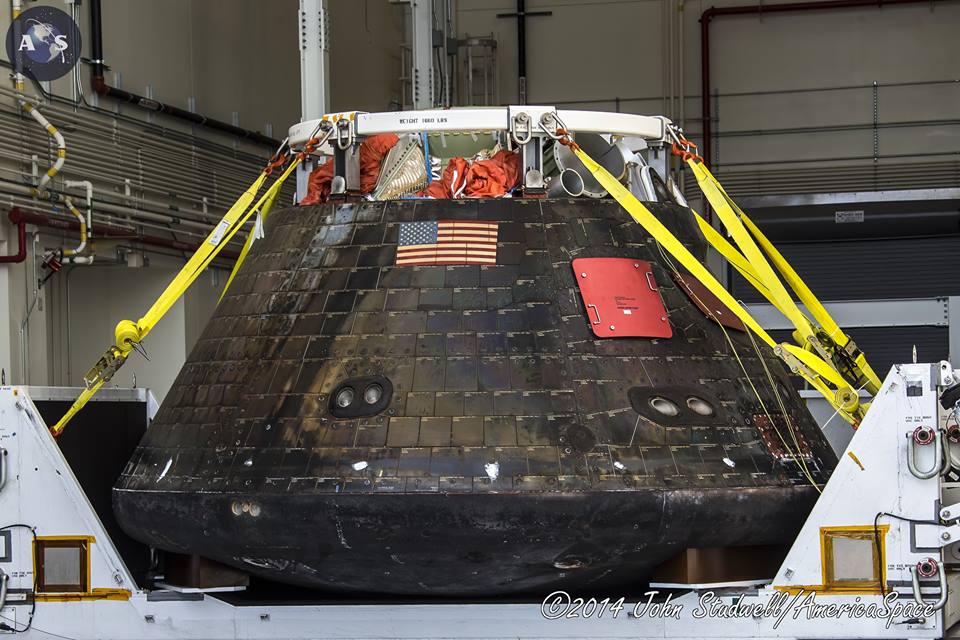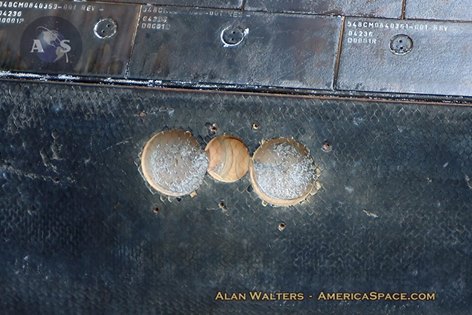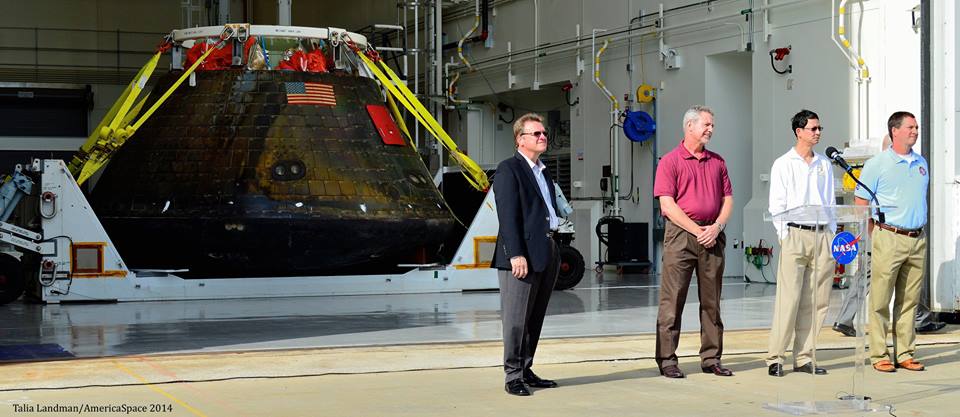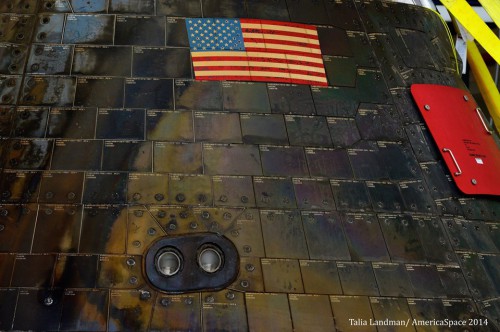
NASA’s Orion spacecraft is back home after making its way cross-country from California to the east coast of Florida after a successful experimental test flight, EFT-1, which took place over four hours on Dec. 5. Orion was not expected to arrive back at the Kennedy Space Center (KSC) until Christmas, which made its early arrival a treat for those working on the program.
“We are so happy today to announce the homecoming the of the Orion spacecraft,” said NASA commentator Mike Curie as he addressed the media the morning of Friday, Dec. 19.
“It was exactly two weeks ago today that it launched from Space Launch Complex 37, right over there, Cape Canaveral Air Force Station. Went 66 thousand miles around the Earth. Its furthest point out was 3,600 miles. Came screaming back into earth at 20,000 mph building up 4,000 degree Fahrenheit temperatures on the heat shield that you see here and made a pin point landing, splash down, in the pacific ocean 600 miles off the coast of California; Traveled the 600 miles back ashore and then completed a trek of 2700 miles across the U.S. arriving here at Kennedy, yesterday, and we are so pleased to have Orion back.”

NASA’s Orion Spacecraft arrived back at the space center where it will undergo an in-depth analysis of the data it collected during its trip to space. The information Orion collected will provide engineers with detailed information on how well the spacecraft held up during its two-orbit test-flight, known as Exploration Flight Test 1.
Members of the media were invited to view the next generation spacecraft inside NASA’s Launch Abort System Facility (LASF) at KSC. The spacecraft showed obvious signs of wear and tear, but nothing unexpected was reported. A NASA release stated that there were strikes on the sides of Orion from some micrometeoroid orbital debris.
Jules Schneider, Orion Project Manager for Lockheed Martin, said 85 out of 87 of Orion’s flight objectives were met during the EFT-1 mission. The two flight test objectives not met were considered to be minor and will be the first to undergo investigation at the start of the new year. The first objective was two airbags that deflated after Orion splashdown, and the second objective was one airbag that did not deploy.
During the Q&A session, AmericaSpace reporter Ken Kremer asked how the heat shield held up and how the Orion team felt of its overall performance. The testing of Orion’s heat shield made up a big part of the EFT-1 mission. Schneider explained the outcome of the heat shield and plans for future testing.
“The heat shield performed very well. I don’t know if you can tell, we’ve actually taken a few core samples off the heat shield already and we’re looking at those,” said Schneider, gesturing to the spacecraft. “We will be removing the heat shield from this vehicle later in February so we will get an ever better look at it.”

The Orion spacecraft was assembled and prepared for launch at KSC. Now engineers will remove the back shell of the spacecraft and perform inspections of its propulsion system, fluid lines, avionics boxes, and cabling. The samples taken off the heat shield have already been sent to a laboratory where they will undergo examinations of their thickness, strength, and charring. The information collected will be used to make improvements to Orion’s design before Exploration Mission-1 (EM-1) when it will launch off of NASA’s new heavy lift rocket, the Space Launch System (SLS), for an uncrewed orbit around the moon at the end of 2017.
“Everybody was incredibly pleased with the performance of the vehicle,” stated Jules Schneider of Lockheed Martin. “And I think you can tell it came through the ‘trial-by-fire’ pretty well.”
Louie Garcia, NASA’s Ground Operations Manager, described the cross-country, 2,700-mile road trip with the precious $350 million spacecraft:

“It was an honor and a privilege to bring America’s Orion spacecraft back home to Kennedy Space Center. We departed Naval Base San Diego Wednesday, December 10th around 10 pm and we arrived yesterday December 18th at noon. Our 7-member team consisting of NASA, Jacobs, and Lockheed Martin personnel worked collectively with the carrier to travel through eight states in eight days. We provided conditioned air to the crew module while monitoring the crew module temperatures. We took hazardous readings at every stop, and provided 24-hour security. Our convoy also had another tractor-trailer with a spare purge unit and generator, spare parts, and tools. We had an extra tractor in the convoy in case we needed to change the tractor out. The weather in route cooperated nicely and we’re thrilled to be back here at the Kennedy Space Center.”
One of the first pieces of data collected upon Orion’s return was a video recorded through windows in the spacecraft’s crew module. NASA released the video highlighting the return of Orion through Earth’s harsh atmosphere. It puts into perspective what an astronaut may experience when returning from beyond low-Earth orbit.
The video titled Astronaut’s-Eye View inside NASA’s Orion Spacecraft begins 10 minutes before Orion’s splashdown in the Pacific Ocean, at 11:29 a.m. EST. In a statement released with the video, NASA said: “the spacecraft was beginning to experience Earth’s atmosphere. Peak heating from the friction caused by the atmosphere rubbing against Orion’s heat shield comes less than two minutes later, and the footage shows the plasma created by the interaction change from white to yellow to lavender to magenta as the temperature increases.”
The first test flight of Orion is the “next giant leap” on NASA’s journey to Mars (check out our EFT-1 launch gallery). The next time Orion will launch will be sometime in late 2018. It will launch on top of NASA’s new deep space rocket, the Space Launch System, and make one orbit around the moon.
Work has already started on the next Orion crew module. The current crew module will be refurbished for use in the test of Orion’s launch abort system, Ascent Abort-2, in 2018.
Don’t forget to “Like” AmericaSpace on Facebook and follow us on Twitter (@AmericaSpace) and Instagram
Missions » SLS » EFT-1 »




2 Comments
2 Pings & Trackbacks
Pingback:Today’s Stuff…Saturday, 12/20/14 | The Grumpy Astronomer
Pingback:McCollister’s Transportation Supports Orion on the Journey To Mars « AmericaSpace